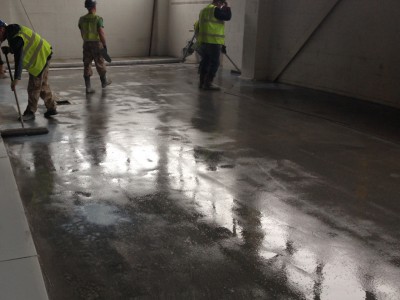Concrete bonding agents: why you need to use them, and which to choose.
When a concrete floor surface becomes damaged there is usually the choice of either demolishing the floor and starting again, or resurfacing the existing concrete. Removing the entire floor and re-pouring is costly, both financially and in terms of time. It’s also wasteful if the floor is still structurally sound. One solution is to add fresh concrete on top of the old surface.
Why you need to use a concrete bonding agent
The cement within a concrete mix doesn’t contain any natural bonding agents – so when fresh concrete is added on top of an existing layer of concrete, the two won’t join together. Once cured, the new concrete will simply sit on top as a separate layer. This will not produce a strong, serviceable floor.
A bonding agent (bonding adhesive) needs to be painted onto the existing concrete first to ensure that the fresh concrete will successfully adhere.
This is also true of floor repairs, if concrete is used to fill gaps caused by damage. The new won’t adhere to the old without the help of a bonding adhesive.
Surface preparation for a bonding agent
If an existing concrete surface has laitance (a dusty layer of cement and fine aggregates), or has been contaminated with spillages such as oil or grease, then the bonding agent won’t work well. Surface preparation is absolutely vital to ensure that the bonding agent is applied to a sound concrete surface. This involves intensive cleaning, usually by pressure washing (you may also want to consider our Decap Roc floor cleaning solvent), or vacuum shot blasting.
If there are spillages which have seeped into the floor’s surface, grinding or milling may be necessary to remove the top few millimetres of the existing floor’s surface to get down to clean concrete.
Which bonding agent to choose?
Rocland offers three different bonding agents. The choice depends on where the bonding agent will be used, and the likely use of the final floor surface.
- Roc Latex is supplied is a synthetic resin liquid which needs to be mixed with water, sand and cement to make a slurry. This can be applied to an existing concrete surface before adding a screed, mortar on concrete on top while it is still sticky. It can also be used before adding a resin surface, and for mortar and masonry joint repairs.
- Roc Prim is a two-part epoxy resin concrete adhesive, which is mixed together on site. It is used to bond two layers of concrete together, and also acts as a moisture vapour barrier between the two layers.
- Placeo Cemcol is a super-strong concrete bonding adhesive, and the best choice for instances where the top surface will contain hard aggregates, or be subject to heavy traffic. It is supplied as a powder, which needs to be mixed with water on site and applied to a slab which has been drenched with water the day before.
The bonding agents should be carefully and thoroughly applied, either with a brush, a broom or a roller – or for larger areas they can be sprayed on.
For specific guidance on choosing the most appropriate bonding agent for your project, please get in touch and we will pleased to help.




